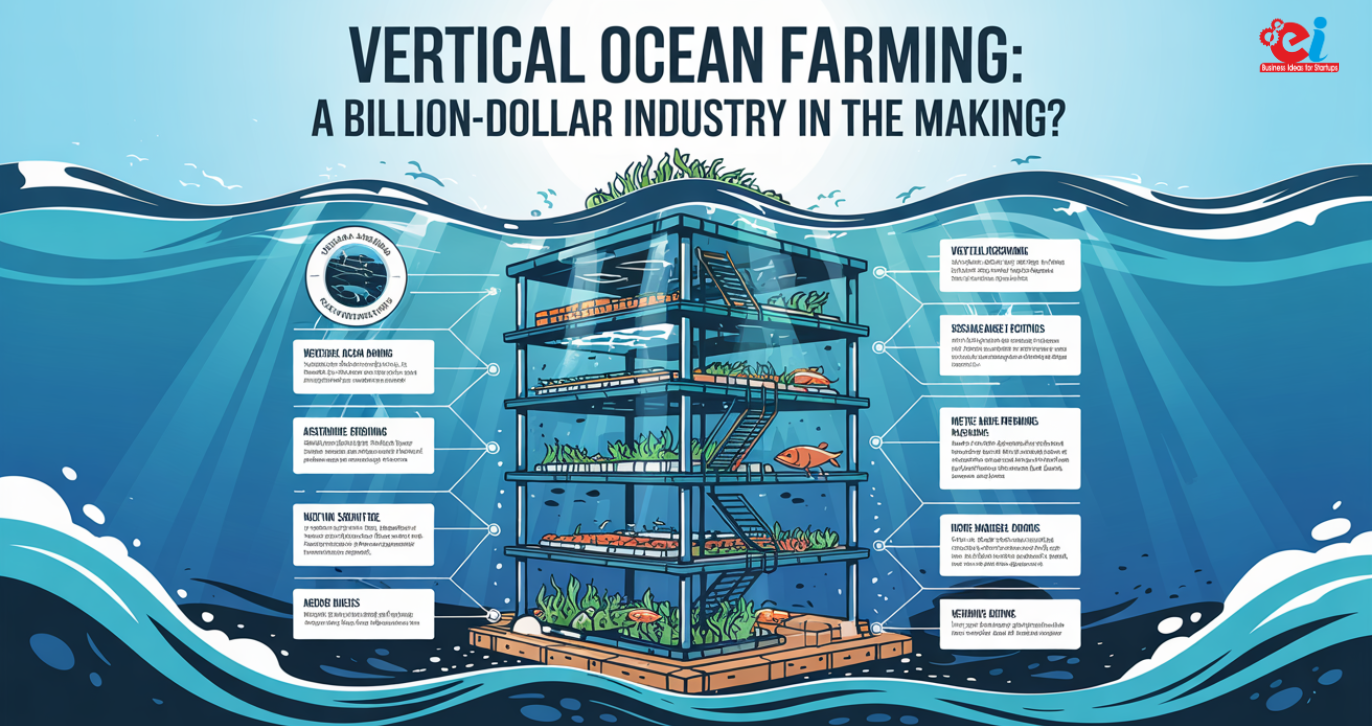Innovative regulation and economic changes need to be made to achieve sustainable food production with growing concerns about climate change, food security, and overfishing. In terms of contributing to the aquaculture and agriculture sectors, the most promising developments include vertical ocean farming. Let’s check out the scope of vertical ocean farming, its economic viability, environmental benefits, and hurdles faced.
Understanding Vertical Ocean Farming
So, vertical ocean farming is a three-dimensional farming system in which seaweed, shellfish, and other marine crops grow by floating in the ocean. Unlike traditional farming, in which one gets to clear up so much forest land and uses millions of acres on the surface and adds damage to terrestrial ecosystems, vertical ocean farms would carry out this activity harmoniously with marine ecosystems.
The standard vertical ocean farm consists of
- Seaweed lines. These are suspended from buoys and are to grow strains of fast-growing seaweeds such as kelp.
- Shellfish cages. These allow mussels, oysters, and scallops to develop on their own in the theatre of the ocean while filtering ocean water.
- Fish habitats. Many of the farms set up pens for fish to encourage biodiversity and sustainable seafood.
It is a low-impact high-yield production method for food without fertilizers or freshwater or artificial feeds, making it one of the most environment-friendly food-producing methods available nowadays.
Economic Potential
Seaweed and shellfish are among the many components included in the aquaculture market, which is already valued at over $250 billion worldwide. Market research further sets the seaweed industry itself at an estimated $30 billion market by 2028. There is a big chance that if vertical ocean farming happens to be scaled up, then it is going to easily land in the billion-dollar revenue stream within a decade. The factors of economic importance include:
- Seaweed Product Versatility: Seaweed does not stop at just the kitchen but moves to other sectors, such as pharmaceuticals, cosmetics, biofuels, and fertilizers.
- Government Support: The United States, Norway, and China heavily invest in ocean farming research and development.
- New Jobs and Coastal Revitalization: Sea farming could bring new forms of employment to coastal communities, thereby reducing some dependence on dwindling fisheries.
Also Read: Organic Farming Business – Big Investment Opportunity in Agriculture Sector
Environmental Impacts
While there are myriad positive impacts accrued from vertical ocean farming, the environment counts among its great benefits. Contrary to conventional farming, which is often associated with deforesting and degrading the soil, vertical ocean farming promotes oceanic ecosystems in diverse, mainly positive ways
1. Restoration of Marine Ecosystems
Vertical Ocean farming creates artificial habitats under which marine biodiversity is maintained.
Oysters and mussels, types of shellfish, filter pollutants from the water, thus enhancing the general health of oceans.
2. Reduced Pressure on Overfishing and Land Use for Agriculture
Ocean farming produces sustainable seafood and plant-based alternatives.
Hence, it puts pressure on wild fisheries and minimizes land under agriculture which is usually accompanied by habitat destruction.
Challenges and Barriers to the Scaling-Up of Vertical Ocean Farming
Despite its promise, vertical ocean farming faces big challenges that the industry must address to prosper:
1. Regulatory Constraints
Marine farming requires government evaluation, environmental permits and compliance, zoning clearances, and strict environmental norms. An easier road for regulations would help lure investments into ocean farming.
2. Investment and Infrastructure Cost
The infrastructure requirements for ocean farming are very specialized and require a huge financial injection upfront. It is important to work economically on farming structures and attract investment to ensure successful operation.
3. Market Acceptance and Consumer Awareness
There remains the challenge of consumer acceptance in the Western markets, despite seaweeds and shellfish being acknowledged in many cultures. So, it follows that marketing and education about seaweed-based foods and sustainable seafood will play a critical role in bridging the gap.
4. Climate and Weather Risks
Oceanic farms are under severe threat from harsh conditions, be they hurricanes, inclement weather, or abrupt rises in ocean temperature. Developing appropriate technologies for climate-resilient farming is thus extremely needed.
Also read: How Moringa Farming and Powder Production Can Be Profitable
The Future Ocean Farming
With the increase in demand for sustainable food sources, vertical ocean farming is slowly but surely set to take off. Several start-ups and companies are gaining traction in the marketing of ocean farming.
Leading Innovations in the Industry
GreenWave is a pioneer company that regeneratively farms the ocean, creating low-cost seaweed and shellfish farm opportunities. Ocean Rainforest in Europe is in the business of large-scale kelp farming for food, biofuels, and pharmaceuticals. Cascadia Seaweed is also working with the Indigenous peoples to set up sustainable seaweed farms.
Closing Thoughts
The bottom line is that vertical ocean farming may even be a billion-dollar industry-disrupting food production and simultaneously restoring ocean ecosystems. If pursued with investments, policies, and innovations, this cutting-edge farming will become a key approach in solving global queries about food security and climate change. The blue revolution just might be around the corner as ocean farming companies and governments begin to leverage this opportunity for the economy and environment. The point in time when oceans will become sustainable food systems for generations to come, as opposed to merely providing seafood, thereby enriching the life of the next generation, would indeed qualify as a revolution.















